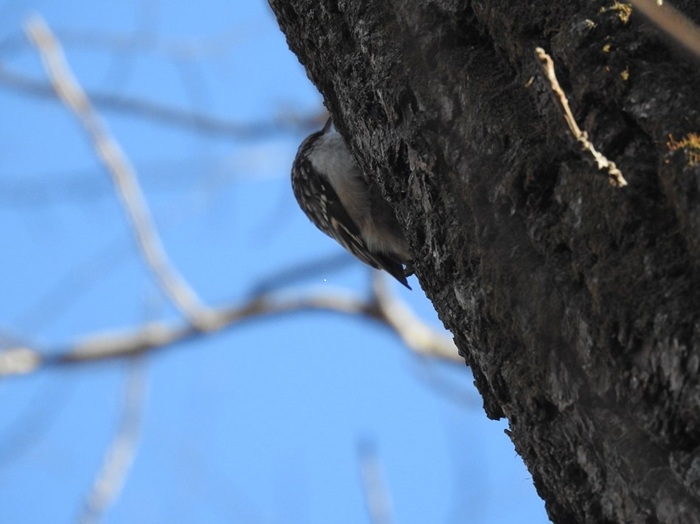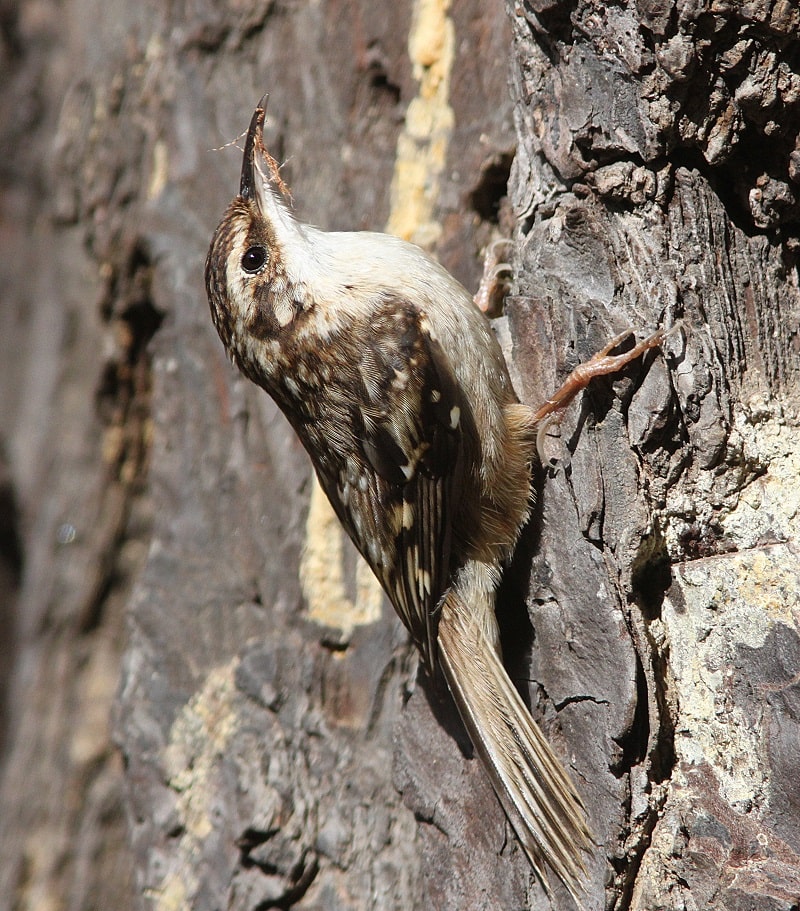Brown Creeper: Hearing Before Seeing
Description: Size, Field Marks
Brown Creepers are tiny woodland birds with unique nesting habits and a set of physical characteristics that help them survive in their natural habitat.
These birds have brown plumage on their back and wings, with white underparts. They also have a distinctive white stripe above their eyes and a curved bill.

Their wings are short and rounded, and their tails are long and stiff, which helps them maintain balance while climbing trees.
The Brown Creeper's beak is slender, long, and slightly curved downward. This unique shape helps them probe into crevices and pick at loose bark to find insects and spiders.
They also use their beak to build their hammock-shaped nests behind peeling bark.
The Brown Creeper's brown and white plumage helps them blend in with the bark of trees, making them difficult to spot.
They also move slowly and methodically up a tree while feeding, which helps them avoid detection by predators.
Brown Creeper Call
Learn his call because you'll miss him if you don't. It's one of the best ways to spot them.
Mating: Breeding Season
Brown Creepers are monogamous birds and form pair bonds during the breeding season and do not mate for life.
The breeding season of the brown creeper typically starts in early spring, around April, and can go through July.
Courtship usually begins with the male singing a high-pitched song to attract a female.
The song is usually heard during the early morning hours and is characterized by a series of short, high-pitched notes.
The male also performs a series of aerial displays to attract the female's attention.
These displays include flying in circles, chasing the female, and performing a series of acrobatic maneuvers.
Nesting Habits
Once a pair bond is formed, the male and female begin to build a nest together. The nest is typically built behind loose bark on a tree trunk or in a tree cavity.
Both male and female brown creepers contribute to building the small, cup-shaped nest from a variety of materials such as twigs, bark, moss, and lichen.
The female usually takes the lead in selecting the nest site and shaping the nest cup, while the male gathers and brings materials to the nest site.
They choose trees with flaky bark, such as pine, spruce, and cedar, that provide excellent cover for their nests. They also prefer trees with a diameter of at least 10 inches.
Depending on tree size, the nest can be anywhere from a few feet to over 100 feet above the ground. The average is 10 to 30 feet above the ground.
| Brown Creeper Nesting Stats | |
|---|---|
| Eggs | 5 - 6 |
| Incubation | 15 - 17 days |
| Nestling Phase | 15 - 17 days |
| Broods | 1 |
The female lays a clutch of 5-6 whitish eggs dotted with reddish-brown spots, and she only will incubate the eggs. Incubation last 15 to 17 days.
During incubation, the male may feed the female. After hatching, both parents bring food for the nestlings.
The nestlings are fed by both parents a diet of insects, spiders, and pupae.
The young leave the nest 15 to 17 days after hatching but will remain in the vicinity of the nest for several days, being fed by their parents.
They'll be able to fly and forage on their own after 30-32 days. Only 1 brood is raised each season.
Feeding Habits
Brown Creepers feed by spiraling around tree trunks and branches much like Woodpeckers, searching for insects in crevices and loose bark.
Unlike woodpeckers, Creepers always start at the base of a tree and spiral upward around the trunk, then fly to the bottom of the next tree to repeat the process.
They are insectivorous birds that primarily feed on insects, spiders, and other small invertebrates.
They are also known to consume seeds, occasionally visiting bird feeders during winter for suet.

Favorite foods in the wild include spiders, weevils, beetles, scale insects, ants, leafhoppers, caterpillars, and other small invertebrates.
Brown Creepers are known to be solitary feeders, and they do not form flocks during feeding. They are active during the day and are most active during the early morning and late afternoon.
Habitat and Distribution
Brown Creepers are primarily found throughout North America, from Alaska and Canada to Mexico. The name "creeper" refers to the bird's unique method of moving along tree trunks.
They inhabit both coniferous and deciduous woodlands, but prefer the former.
These birds are most commonly found in forests with large trees, both alive and dead, which provide suitable nesting and foraging sites.
Brown Creepers are known to forage on the trunks and limbs of trees, slowly climbing with their tails braced against the surface, examining bark visually, and probing in crevices.
They breed in the northern part of their range, including Alaska and Canada, and migrate to the southern part of their range during the winter months.
Are Brown Creepers Rare?
Even though they're difficult to locate, the Brown Creeper is a common bird species with a population of greater than 9 million individuals.
According to the North American Breeding Bird Survey, the population has remained stable over the past few decades.
However, there are concerns about the long-term viability of the population due to habitat loss.
Wildlife managers are working to conserve and restore forest habitats to support healthy Brown Creeper populations.
Are They Endangered?
Currently, the Brown Creeper is not listed as an endangered species. However, it is considered an indicator species, meaning that its presence or absence can indicate the health of the forest ecosystem.
Therefore, conservation efforts to protect the Brown Creeper's habitat can benefit other forest species as well.
Conservation efforts for the Brown Creeper are led by organizations such as Audubon, which works to protect and restore forest habitats across North America.
These efforts include promoting sustainable forestry practices, protecting critical habitat areas, and educating the public about the importance of forest conservation.
Brown Creeper Predators
Brown Creepers face a variety of predators, including birds of prey, snakes, and mammals.
The most common predators of Brown Creepers are the Sharp-shinned Hawk, Cooper's Hawk, and the domestic cat.
Snakes, such as the Eastern Rat Snake, are also known to prey on Brown Creepers, as are mammals like the Red Squirrel and the Eastern Chipmunk.
Habitat Threats
Brown Creepers face several threats to their survival, including habitat loss and fragmentation.
Logging, timber harvesting, clear-cutting, selective cutting, and salvage-logging are all practices that can lead to habitat loss and fragmentation.
As a result, Brown Creepers may have difficulty finding suitable nesting and foraging sites, which can negatively impact their reproductive success.






